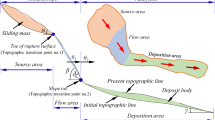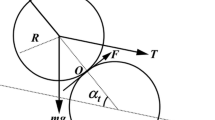Abstract
Laterally confined rock avalanches are the most typical rock avalanches with extreme destructive potential in mountainous regions. The tremendous hazards and complicated kinematics mechanism highlight the necessity to understand their mobility and deposit characteristics. In this study, a series of small-scale physical experiments are carried out to reproduce the migration and deposit processes of rock avalanches using an inclined chute setup, and this study focuses on the effects of several independent variables including material types (M), landslide volume (V), and slope angle (α) on mobility and deposit of rock avalanches. The sensitivity analysis results highlight the significant influence of material types (M) and slope angle (α) on peak velocity (\({\nu }_{\mathrm{max}}\)) and travel distance (L). The dimensionless equations for quantitative describing the relationship between significant influential factors and motion parameters were established by the regression analysis method. On this basis, the empirical formulae with full consideration of the effects of various factors were proposed for the estimation of peak velocity and travel distance. Furthermore, the travel angle and deposit angle were identified as significant parameters that represent the mobility and deposit features of granular flows, respectively. The relationship between these parameters is accurately described by a fitted empirical linear model. This model may provide valuable insights into our understanding of the mobility and deposit characteristics of granular flows.









Similar content being viewed by others
Data Availability
All data generated or analysed during this study are included in this published article.
References
Bowman ET, Take WA, Rait KL, Hann C (2012) Physical models of rock avalanche spreading behaviour with dynamic fragmentation. Can Geotech J 49(4):460–476
Basharat M, Rohn J (2015) Effects of volume on travel distance of mass movements triggered by the 2005 Kashmir earthquake, in the Northeast Himalayas of Pakistan. Nat Hazards 77(1):273–292
Campbell CS (1989) Self-lubrication for long runout landslides. J Geol 97(6):653–665
Cagnoli B, Romano GP (2012) Effects of flow volume and grain size on mobility of dry granular flows of angular rock fragments: a functional relationship of scaling parameters. Journal of Geophysical Research Solid Earth 117:2207–2220
Chen XZ (1994) Research on the strength of coarse grained soil and the interlocking force. Engineering Mechanics 11(4):56–63. (In Chinese)
Davies TR, McSaveney MJ, Hodgson KA (1999) A fragmentation-spreading model for long-runout rock avalanches. Can Geotech J 36(6):1096–1110
Manzella I, Labiouse V (2008) Qualitative analysis of rock avalanches propagation by means of physical modelling of not constrained gravel flows. Rock Mechanics Rock Engineering 41(1):133–151
Manzella I, Labiouse V (2009) Flow experiments with gravel and blocks at small scale to investigate parameters and mechanisms involved in rock avalanches. Eng Geol 109(1–2):146–158
Davies TR, Reznichenko NV, McSaveney MJ (2020) Energy budget for a rock avalanche: fate of fracture-surface energy. Landslides 17(1):3–13
Dufresne A (2012) Rock avalanches experiments on the interaction with stationary runout path materials and comparison to rock avalanche events. Earth Surface Process and Landforms 37(14):1527–1541
Fan XY, Tian SJ, Zhang YY (2016) Mass-front velocity of dry granular flows influenced by the angle of the slope to the runout plane and particle size gradation. J Mt Sci 13(2):234–245
Guo DP, Hamada M, He C, Wang YF, Zou YL (2014) An empirical model for landslide travel distance prediction in Wenchuan earthquake area. Landslides 11(2):281–291
Ge YF, Zhou T, Tang HM, Lin ZS (2020) Influence of the impact angle on the motion and deposition of granular flows. Eng Geol 275:105746
Ge YF, Tang HM, Li CD (2021) Mechanical energy evolution in the propagation of rock avalanches using field survey and numerical simulation. Landslides 18:3559–3576
Heidenreich B (2004) Small and half-scale experimental studies of rockfall impacts on sandy slopes. Ph.D. thesis no. 3058, Ecole Polytechnique Fédérale de Lausanne, CH
Hungr O, Leroueil S, Picarelli L (2014) The Varnes classification of landslide types, an update. Landslides 11(2):167–194
Hu W, Scaringi G, Xu Q, Pei Z, Van Asch TW, Hicher PY (2017) Sensitivity of the initiation and runout of flowslides in loose granular deposits to the content of small particles: an insight from flume tests. Eng Geol 231:34–44
Iverson RM, Logan M, Denlinger RP (2004) Granular avalanches across irregular 3 dimensional terrain: 2 experimental tests. Journal of Geophysical Research Atmospheres 109(F1):1–16
Kozik SM (1962) Computing snow avalanche motion. Gidrometeoizdat, Leningrad, p p76
Liu ZN, Koyi HA, Swantesson JOH, Nilfouroushan F, Reshetyuk Y (2013) Kinematics and 3-D internal deformation of granular slopes: analogue models and natural landslides. J Struct Geol 53:27–42
Liu HW, Zhao XY, Xiao D (2021) Effects of local topography on the mobility of rock avalanches: a statistical analysis based on 36 cases from south-western China. Eng Geol 294:106351
Mitchell A, McDougall S, Nolde N, Brideau MA, Whittall J, Aaron JB (2020) Rock avalanche runout prediction using stochastic analysis of a regional dataset. Landslides 17:777–792
Plafker G, Ericksen GE (1978) Nevados Huascaran avalanches, Peru. In: Voight B (ed) Rockslides and avalanches. Elsevier, Amsterdam, pp 277–314
Qiu HJ, Cui P, Hu S, Regmi A, Wang XG, Yang DD (2018) Developing empirical relationships to predict loess slide travel distances: a case study on the loess plateau in China. Bull Eng Geol Env 77:1299–1309
Rickenmann D (1999) Empirical relationships for debris flows. Nat Hazards 19(1):47–77
Rodriguez-Sedano LA, Sarocchi D, Sulpizio R, Borselli L, Campos G, Moreno Chavez G (2016) Influence of particle density on flow behavior and deposit architecture of concentrated pyroclastic density currents over a break in slope: insights from laboratory experiments. J Volcanol Geoth Res 328:178–186
Salm B (1966) Contribution to avalanche dynamics. IAHS AISH Publ 69:199–214
Shreve RL (1968) Leakage and fluidization in air-layer lubricated avalanches. Geol Soc Am Bull 79(5):653–658
Strom AL, Li L, Lan H (2019) Rock avalanche mobility: optimal characterization and the effects of confinement. Landslides 16:1437–1452
Tang HM, Wasowski J, Juang CH (2019) Geohazards in the three Gorges Reservoir Area, China-lessons learned from decades of research. Eng Geol 261:105267
Wang YF, Cheng QG, Lin QW, Li K, Yang HF (2018) Insights into the kinematics and dynamics of the Luanshibao rock avalanche (Tibetan Plateau, China) based on its complex surface landforms. Geomorphology 317:170–183
Wang YF, Cheng QG, Shi AW, Yuan YQ, Yin BM, Qiu YH (2019) Sedimentary deformation structures in the Nyixoi Chongco rock avalanche: implications on rock avalanche transport mechanisms. Landslides 16:523–532
Wu YS, Wang DM, Li PS, Niu ZY (2022) Experimental investigation of dry granular flows down an inclined channel against a wall-like obstacle of limited width. Acta Geotechnica
Yang HL, Pei Z, He ZH, Lei J, Xia XT (2022) An empirical model for the travel distance prediction of deflection-type rock avalanches in the Wenchuan earthquake area. Front Earth Sci 10:944549
Yang QQ, Cai F, Ugai K et al (2011) Some factors affecting mass-front velocity of rapid dry granular flows in a large flume. Engineering Geology 122:249–260
Yin YP, Xing AG (2012) Aerodynamic modeling of the Yigong gigantic rock slide-debris avalanche, Tibet, China. Bull Eng Geol Env 71(1):149–160
Zhan WW, Fan XM, Huang RQ, Pei XJ, Xu Q, Li WL (2017) Empirical prediction for travel distance of channelized rock avalanches in the Wenchuan earthquake area. Nat Hazard 17(6):833–844
Zhang M, Wu L, Zhang J, Li L (2019) The 2009 Jiweishan rock avalanche, Wulong, China: deposit characteristics and implications for its fragmentation. Landslides 16(5):893–906
Zhang M, Yin YP (2013) Dynamics, mobility-controlling factors and transport mechanisms of rapid long-runout rock avalanches in China. Eng Geol 167:37–58
Zeng QL, Zhu JW, Liao LY, Wei RQ, Ma FS, Ma XP, Yuan B (2021) High mobility of the channelized ancient Linka rock avalanche within the Bangong-Nujiang suture zone, SE Tibetan Plateau. Eng Geol 282:10599
Zheng G, Xu Q, Peng SQ (2018) Chute experiments of the long-runout distance of rock avalanches (in Chinese). Chin J Rock Soil Mech 40(12):1–10
Zhou J, Xu F, Guo C (2016) Effects of model parameters, topography, and scale on the mass movement processes of rock avalanches using the discrete element method. Arab J Geosci 9(5):418–432
Acknowledgements
We sincerely thank the anonymous reviewers for their constructive and valuable suggestions, which help improving this manuscript substantially.
Funding
This work was supported by the National Natural Science Foundation of China (41877524; 41907254). The first author is financially supported by the China Scholarship Council.
Author information
Authors and Affiliations
Corresponding author
Rights and permissions
Springer Nature or its licensor (e.g. a society or other partner) holds exclusive rights to this article under a publishing agreement with the author(s) or other rightsholder(s); author self-archiving of the accepted manuscript version of this article is solely governed by the terms of such publishing agreement and applicable law.
About this article
Cite this article
Yang, H., Pei, X., Fan, X. et al. Experimental investigation of the mobility and deposit characteristics of laterally confined rock avalanches. Bull Eng Geol Environ 82, 192 (2023). https://doi.org/10.1007/s10064-023-03191-7
Received:
Accepted:
Published:
DOI: https://doi.org/10.1007/s10064-023-03191-7




